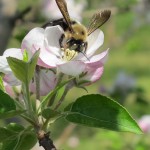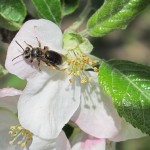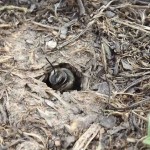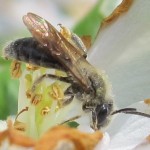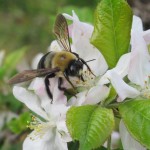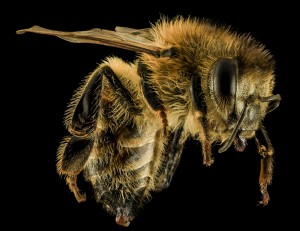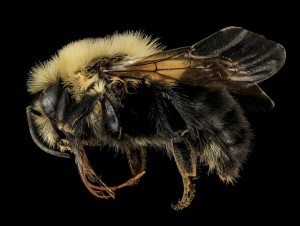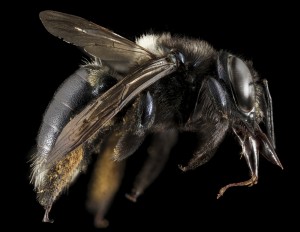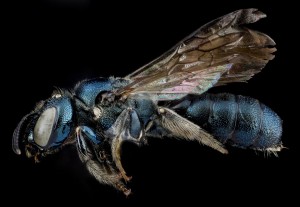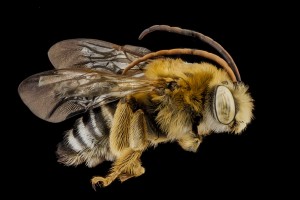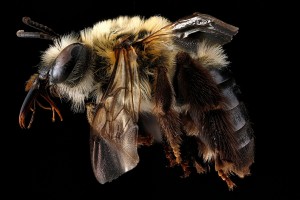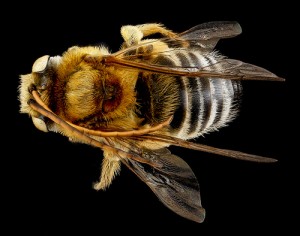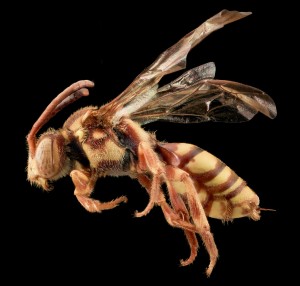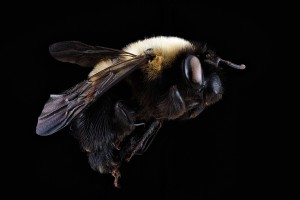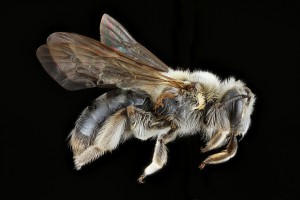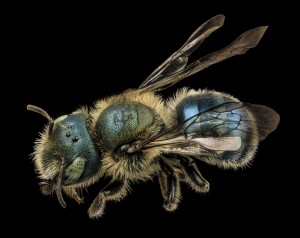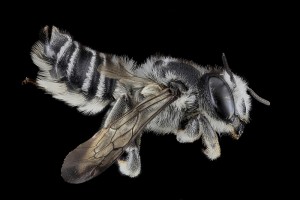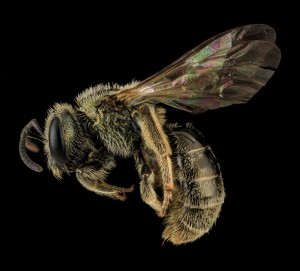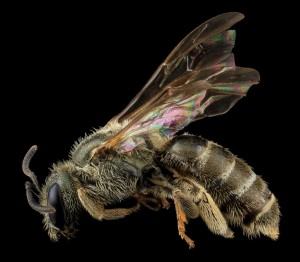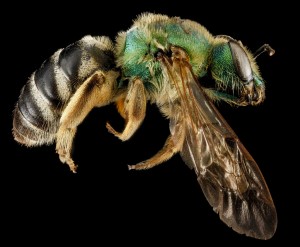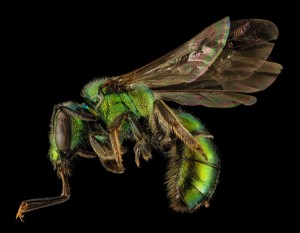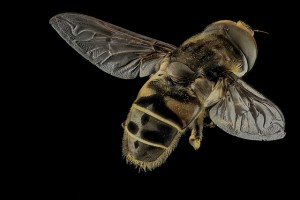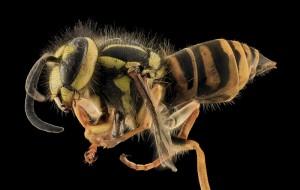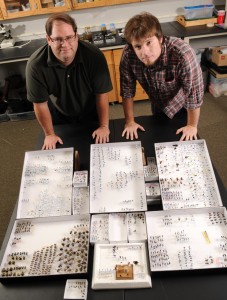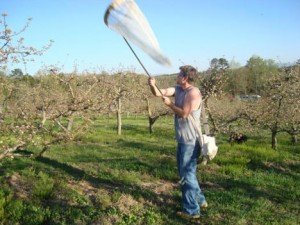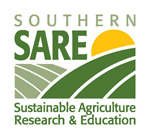- Bombus griseocollis on Apple Flower (Front view)
- Mining Bee on Apple Flower
- Andrena crataegi at Nest Entrance
- Sweat Bee on Apple Flower
- Andrena crataegi
- Carpenter Bee male – front view
This website’s main goal is to provide easy bee identification and clear information for farmers and the general public.
Bees are responsible for the pollination of almost every fruit, nut, and vegetable crop. Bees pollinate 1 of every 3 bites of food we eat. Most bee species are important pollinators of our food crops. Recent estimates suggest that bees contibute $15 Billion in pollination services to the U.S. economy each year.
Reliance on a single insect species, the honeybee, for the pollination of over 1/3 of the human food supply can be dangerous. Indeed, this is especially true considering that honeybee populations are in decline, thus putting the global food supply at risk. In 2006, the situation worsened with a significant increase in honeybee losses (30-90% of a colony). These losses were documented particularly in the East Coast of the United States, due to the phenomenon labeled Colony Collapse Disorder (CCD).
The reduced availability of honeybee colonies has increased food production costs and reduced potential crop yields. Most farmers are dependent on rented honeybee hives in order to ensure their crops are fully pollinated. The shortage of honeybee colonies has resulted in a rapid increase in the cost of renting honeybee hives. Further declines of honeybee populations could have a devastating effect on agricultural production. Alternative pollination strategies that are less dependent on the honeybee must be developed in order to ensure long-term sustainably of insect pollinated crops.
The best pollination alternative to honeybees is the native bees already present in the local environment. There are over 17,000 bee species in the world. With nearly 3500 bee species in North America alone, the diversity of different forms (size, pubescence, etc.), pollen-strategies, and behaviors (early spring emergence, prolonged daily foraging, shorter inter-flower travel, etc.) provide an effective native bee pollinator for every fruit, nut, and vegetable crop.
Data concerning regional make-ups of these native pollinator-guilds are severely lacking, which has led to farmer’s reliance on the European honeybees. Therefore, research is needed to determine which native bees are present in a given region. We hypothesize that native bees can supplement or even replace the honeybee in apple and other fruit and vegetable pollination in Georgia.
Photograph Key of the Bees of Georgia
Click on the bee name under the photo below to learn more about the select group of bees and to see high quality photos of some of the species in each group.
- Honeybee
- Bumblebee
- Carpenter Bee
- Small Carpenter Bee
Honeybee |
Bumblebee |
Carpenter Bee |
Small Carpenter Bee |
- Long Horned Bee
- Alfalfa Long Horned Bee
- Squash Bee
- Cuckoo Bee
Long Horned Bees |
Alfalfa Long Horned Bees |
Squash Bees |
Cuckoo Bees |
- Blueberry Bee
- Mining Bee
- Mason Bee
- Leaf Cutter Bee
Blueberry Bees |
Mining Bees |
Mason Bees |
Leaf Cutter Bees |
- Small Sweat Bees
- Banded Sweat Bees
- Large Green Sweat Bee
- Small Green Sweat Bees
Small Sweat Bees |
Banded Sweat Bees |
Large Green Sweat Bees |
Small Green Sweat Bees |
These groups are not bees; however, they may look like bees.
- Hoverfly
- Wasp
Hoverflies |
Wasps |
The Georgia Native Bee Biodiversity Assessment Project
The Georgia Native Bee Biodiversity Assessment began in 2010 as a survey of the native bees of Georgia. Professor Mark Schlueter coordinates the project and the project’s lead taxonomist is Nicholas Stewart. The majority of native bee collections during 2010-2015 have been in North Georgia near apple orchards. Limited surveys were also performed in several state parks. This is due to the fact that the highest bee species diversity and abundance has been found in the orchards. The survey typically begins sampling bees in early March and finishes in late September. To date we have collected over 20,00 bees representing nearly 200 species.
One of the projects goals is to determine which native bee species are abundant in agricultural areas. Then, to determine which of these common species may be a good replacement or supplement for the declining honeybee in Georgia agriculture.
List of Bee Species Found in Georgia
Publications and Presentations on Georgia Native Bees
Native Bee Abundance and Diversity in Georgia Apple Orchards (Research Article: Published in the Southeastern Naturalist (2015) volume 14(4):721-739.)
National Public Radio Story (Morning Edition)
Broadcasted: Monday, October 10, 2016; Story by Molly Samuel (WAPE 90.1 – Atlanta)
http://news.wabe.org/post/why-georgia-apple-orchard-doesnt-need-honey-bees
Southern SARE (Sustainable Agriculture Research and Education)
Bees of Georgia Research Studies
http://www.southernsare.org/Educational-Resources/SARE-Project-Products/Websites/Bees-of-Georgia
Links to other Bee Identification Sites
Key that uses photographs to identify common bee groups (For beginning users)
Bugguide.net
Detailed interactive key for bee identification (For advanced users)
http://www.discoverlife.org/20/q?search=Apoidea#Identification
Website that describes the collection and identification process
(start here if you want to collect bees)
http://www.extension.org/pages/29761
How to Contact Us:
Mark Schlueter, Ph.D.
Professor of Biology
Georgia Gwinnet College
Lawrenceville, GA 30043
Nicholas Stewart (1982-2017)
Project Taxonomist – In Memory
(Nick’s made a significant impact on biology and the bees of Georgia)
This website was created by Professor Mark Schlueter. It was last updated April 2020.
“This material is based upon work that is supported by the National Institute of Food and Agriculture, U.S. Department of Agriculture, under award numbers: OS11-061, OS12-066, OS13-074, OS13-81, and OS14-90.
